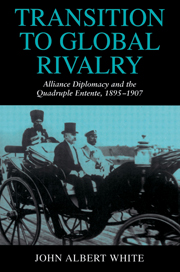Book contents
- Frontmatter
- Contents
- List of illustrations
- List of maps
- Preface
- Chronology
- List of abbreviations
- 1 Portents of conflict
- 2 The focus of hostility
- 3 The emergence of encirclement
- 4 Russia in political recession
- 5 The Algeciras factor
- 6 After Portsmouth and Algeciras
- 7 Imperial truce
- Appendices
- Bibliography
- Index
5 - The Algeciras factor
Published online by Cambridge University Press: 04 August 2010
- Frontmatter
- Contents
- List of illustrations
- List of maps
- Preface
- Chronology
- List of abbreviations
- 1 Portents of conflict
- 2 The focus of hostility
- 3 The emergence of encirclement
- 4 Russia in political recession
- 5 The Algeciras factor
- 6 After Portsmouth and Algeciras
- 7 Imperial truce
- Appendices
- Bibliography
- Index
Summary
The Morocco challenge
The rise and development of the Morocco question and the movement to bring the Russo-Japanese war to a close had by 1905 converged and together had become the focus of the negotiations which were to terminate in a new balance of power. The outcome of these intermittent negotiations had already aligned the Triple Alliance on the one hand and, on the other, the Franco-Russian alliance, the Anglo-French entente, and the Anglo-Japanese alliance against each other.
This was, however, an ill-balanced rivalry. The latter three coalitions included the now defeated Russia as well as Britain and Japan whose main strength was in their naval forces. It also comprised France, now weakened by the defeat of her alliance partner, Russia, and in any case not considered militarily a match for Germany. It was generally assumed that if Germany were successful in preventing these three coalitions from forming a combination or better still, in bringing Russia and France together under her own influence, she would be able in one way or another to control them and thus dominate Europe.
Germany used a number of tactics, all reactive to current experience and all unsuccessful, in her attempt to attain control of her rivals in Europe. The first of these was tried on the occasion of the Dogger Bank incident when ill-feeling toward Britain was still prevalent in Russia and the German Emperor sought to take advantage of the further animosity generated between Britain and Russia in the course of the episode. He used this opportunity to propose a continental alliance based on an affiliation of Germany, Russia, and France.
- Type
- Chapter
- Information
- Transition to Global RivalryAlliance Diplomacy and the Quadruple Entente, 1895–1907, pp. 157 - 203Publisher: Cambridge University PressPrint publication year: 1995



